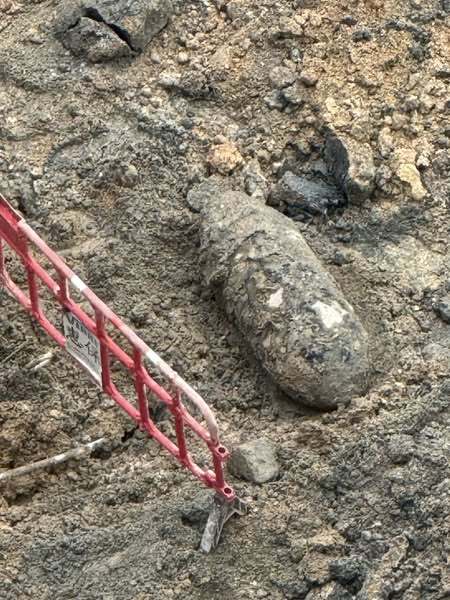Recent news in Hong Kong has been relentless, and as a journalist, I've been working on the frontlines for days. On Sept. 19, I was already stationed on duty by 8 a.m., successfully completing the filming and reporting of an exclusive interview with Hong Kong Chief Executive John Lee alongside my colleagues in the morning. Little did I know that a breaking news story would disrupt the calm that afternoon—a wartime bomb was discovered at a construction site on Pan Hoi Street in Quarry Bay, prompting mass evacuations of residents.
Finding wartime bombs in Hong Kong is not unprecedented. However, this time it hit close to home—literally. The site in question was near my residential building, and I wasn't sure if evacuation orders would include my building. Still at my company, I could only rely on updates from neighbors and friends working nearby to get a sense of the situation. When people began reporting that they had received urgent evacuation notices, I started to feel that this might not be a simple matter.

At that point, online information was chaotic, and no one could confirm precisely which areas needed to be evacuated. People were growing anxious. Was my building part of the evacuation zone? The editorial team in my company quickly made decisions: send reporters to the scene for live coverage and contact local district councilors for authoritative updates.
Once we received the first-hand information from our field reporters, we were the first to break the news: residents of Sunway Gardens, Chung Hing Mansion, and Westlands Court were among those required to evacuate. We also reported that six community centers would soon be opened to shelter affected residents. Meanwhile, our on-site reporters began livestreaming the scene as law enforcement, firefighters, and the bomb disposal unit arrived in increasing numbers and with more equipment. It was clear that this bomb was no ordinary case.
Due to the complexity of the situation, the police press conference, initially scheduled for an earlier time, was delayed by three hours and finally held in the evening. There, the nature of the bomb was revealed: it was a US military AN-M65 standard aerial bomb from World War II. Measuring approximately 1.5 meters in length and weighing about 1,000 pounds, it contained around 500 pounds of high-performance TNT explosives. The bomb's casing was intact and still equipped with both front and tail fuzes, making it likely to remain highly functional and dangerous.
This explained why the bomb presented such a challenge. The police had previously handled seven similar bombs, and the explosives in all cases were found to retain power comparable to their condition during World War II. The potential risks were extremely high. The most recent similar cases occurred in 2018, during the Shatin-Central Link railway construction, where three 1,000-pound aerial bombs were discovered and took between 20 and 26 hours each to defuse. For this incident, a total of 18 buildings, housing approximately 1,900 households and 6,000 people, needed to be evacuated.
Once the police released the list of the 18 affected buildings, my worst fears were confirmed—my residential building was included. The police announced that residents could return briefly to collect essential belongings but must evacuate by 11 p.m. Defusal operations were set to begin at 2 a.m. on Sept. 20. Evacuated residents were advised to stay at community centers or seek other accommodations.
I never imagined that, in 2025, I would be forced out of my home by a bomb from 80 years ago.
After the press conference, it was already 8:30 p.m. Several colleagues who had worked on the morning interview with me volunteered to stay and help cover the breaking news. Arranging to stay with a friend for the night, I decided to return home briefly to grab a change of clothes and other essentials. Taking the MTR to the Quarry Bay Station exit that had been temporarily closed earlier in the day, I was met by residents carrying large bags and suitcases—these were evacuees. Across the street, buses for evacuating residents, ambulances, and police vehicles lined the road, while people hurried by, dragging luggage behind them.




On my way to my building, I was stopped by the police multiple times and asked where I was heading and for what purpose. At the lobby of my building, officers inquired about my floor, repeatedly emphasizing the need to leave as quickly as possible. Notices about the evacuation were posted on the entrance doors, but I had no time to read them in detail. I snapped a photo before rushing into the elevator to my apartment to pack.
After quickly gathering my things, I headed back downstairs, where I was required to register with the police. They asked for my name, apartment unit, number of family members, and contact information, recording the time of my departure. This information would later be used to confirm the evacuation's completion by cross-checking resident lists. In the lobby, I saw a map marking the buildings included in the evacuation zone and several relief supplies provided on-site. After a quick glance, I was escorted out of the area.
At the building's entrance, district councilors and volunteer teams asked evacuees if they needed accommodations. Anyone requiring assistance could register and board shuttle buses arranged for relocation. I must say, the local response this time was impressively swift. Once the evacuation notice was confirmed, district councilors and volunteer teams mobilized quickly to assist residents. I witnessed many volunteers helping elderly residents and families as they departed. The evacuation of 6,000 people, which officially began at 6 p.m., was carried out efficiently and in an orderly manner—worthy of praise.
Later, I joined the media zone to relieve colleagues who had been covering the scene and had yet to eat dinner. Perhaps because it was my colleague's first experience reporting such a major incident, they insisted on staying a little longer at the scene. Not long after, we met the Secretary for Security, Chris Tang, and the Secretary for Home and Youth Affairs, Alice Mak, who had arrived to assess the situation. By the time we finished our coverage, it was already past 10 p.m. Considering my colleagues had work early the next morning, I urged them to leave, volunteering to stay for the final hour of the evacuation.




In the final hour, there wasn't much change on-site. Unlike the earlier constant flow of people leaving, only a few appeared sporadically. Many brought their pets along—cats, dogs, hamsters—all needing to evacuate urgently at night. One by one, the lights in the buildings went out. What was usually a scene of countless lights illuminating the night was now reduced to just a few lonely ones.
At 11 p.m., a few lights still flickered in nearby buildings as the police prepared to conduct door-to-door checks to ensure everyone had evacuated. Once the operations concluded, defusal work was scheduled to begin at 2 a.m., followed by site cleanup and safety checks before the lockdown could be lifted.
Half an hour later, clearance operations were still ongoing, and reporters were being gradually instructed to leave the restricted area. The sound of voices diminished, and the crowd of journalists thinned. I took one last look at the dark silhouette of my home before turning away.
Now, all I can do is leave the task to the bomb disposal experts working through the night. Only by the tireless efforts of the bomb disposal experts can the bomb be safely defused. Only then can residents return home with the first light of dawn.
(Journalist: Akira; English Editor: Zoey SUN)
Related News:
Watch This | Quarry Bay WWII bomb: Police saw through casing, disposal expected by 2 pm




















Comment